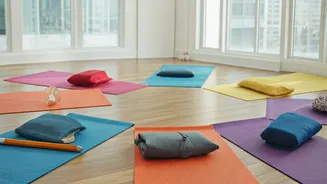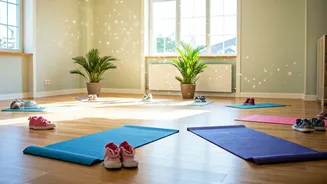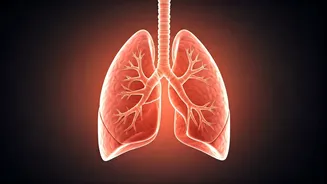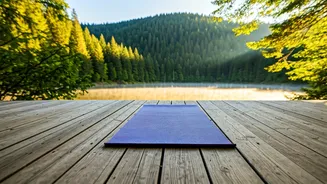Introduction to Yoga
Yoga, an ancient practice, is celebrated for its physical and mental health benefits. For children, it's a powerful tool to enhance cognitive skills. Regularly
practicing yoga asanas can improve focus, memory, and overall well-being. These exercises boost blood flow to the brain, which enhances brain function. Yoga combines movement with controlled breathing, making it a holistic approach to nurturing a child's mind and body. Additionally, it helps reduce stress and anxiety, creating a more conducive environment for learning. It's not just about flexibility; it’s about nurturing a calm and focused state of mind, beneficial for their academic performance and daily life. The integration of yoga into a child's routine can result in long-lasting positive effects.
The Mountain Pose (Tadasana)
Tadasana, or the Mountain Pose, serves as a foundational pose, fostering stability and grounding. To practice, have the child stand tall with feet together, arms by their sides, and shoulders relaxed. They should focus on lengthening their spine and feeling rooted to the ground. This posture enhances body awareness, essential for improving concentration. It cultivates a sense of calm and centeredness, reducing distractions and promoting focus. Encouraging them to imagine a mountain’s steadiness instills a sense of stability. It's a great starting point for any yoga sequence and is easily adaptable. It helps children connect their mind with their physical presence, laying a foundation for more complex asanas. It also improves posture, contributing to overall physical well-being.
The Tree Pose (Vrikshasana)
Vrikshasana, or the Tree Pose, is excellent for enhancing balance and concentration. Children should start by standing straight, shifting their weight to one leg, and placing the sole of the other foot either on the inner thigh or calf of the standing leg, avoiding the knee. Arms can be raised overhead like branches. Maintaining this pose requires focus, helping to improve mental clarity. This pose not only strengthens legs and improves balance but also demands sustained attention, which is critical for cognitive development. Regular practice builds confidence and self-awareness, valuable qualities for navigating academic and social environments. It promotes a feeling of stability and peace, which contributes to an enhanced ability to focus.
The Warrior II (Virabhadrasana II)
Warrior II strengthens both the body and mind. Have the child stand with feet wide apart, one foot turned outwards, and the other facing forward. Bend the front knee over the ankle, ensuring it doesn’t go past the toes. Extend arms out to the sides, gazing over the front hand. This pose builds stamina and sharpens concentration by requiring the child to maintain a challenging position. It develops resilience and determination. The focus required to hold the pose translates into better concentration in other areas of life. The pose encourages children to find their center of strength and determination. It enhances body awareness and promotes mindfulness, contributing to better focus.
The Triangle Pose (Trikonasana)
Trikonasana, or the Triangle Pose, stretches and strengthens various muscle groups while enhancing balance. The child should stand with feet wide apart, and extend one arm towards the ground and the other towards the sky. The gaze should be directed towards the raised hand. This pose promotes mental clarity and reduces stress. It improves blood circulation to the brain, positively influencing cognitive function. It requires sustained attention and balance, fostering a strong sense of focus. The posture stretches the entire body, which has a calming effect, enabling better focus. It instills a sense of stability, helping in the development of concentration skills.
The Cobra Pose (Bhujangasana)
Bhujangasana, or the Cobra Pose, stimulates the brain and enhances concentration. Have the child lie on their stomach with hands under the shoulders. They should then lift their chest off the floor, engaging the back muscles, and looking forward. It's an excellent way to stimulate brain function and increase blood flow, promoting alertness and enhancing memory. The stretch improves posture, vital for overall health. The pose encourages focus and awareness. The Cobra Pose strengthens the spine and alleviates fatigue, contributing to the development of cognitive skills. The pose not only boosts their cognitive abilities, but also instills self-confidence.
The Bridge Pose (Setu Bandhasana)
Setu Bandhasana, or the Bridge Pose, is a gentle backbend that invigorates the mind. Have the child lie on their back, bend their knees, and place their feet flat on the floor close to their hips. They should lift their hips off the floor, forming a bridge with their body. The Bridge Pose calms the brain and reduces stress and depression. It improves blood circulation to the brain, which enhances mental clarity and focus. The pose requires sustained concentration and balance. By practicing this pose, they can improve their ability to maintain focus, which translates to better learning abilities. The increased blood flow supports optimal cognitive function.
The Child's Pose (Balasana)
Balasana, or the Child's Pose, is a resting pose that soothes the mind and body. The child should kneel, bringing their forehead to the floor and stretching their arms forward or resting them by their sides. The Child's Pose provides a break and allows children to center themselves, reducing stress and promoting mental clarity. It's a great exercise for enhancing memory. The pose encourages a sense of calm and helps reduce anxiety. It teaches children to be in tune with their bodies. Regular practice of the Child's Pose fosters a sense of peace, making them more receptive to learning. This pose assists them to relax and refocus, which improves memory and cognitive functions.
The Corpse Pose (Savasana)
Savasana, or the Corpse Pose, teaches relaxation and helps the mind integrate the benefits of the yoga practice. The child should lie flat on their back, arms by their sides, and close their eyes. This pose fosters deep relaxation, helping reduce stress and improving memory. It allows the mind and body to absorb the advantages of the yoga session. It’s an essential part of any yoga practice, assisting in stress reduction and relaxation. This pose cultivates calmness, which makes the child more focused. It creates a space for the child to rest and reset their mind. This enables them to perform better in their tasks that require focus and memory.
Breathing Exercises
Incorporating breathing exercises, such as deep belly breathing or alternate nostril breathing (Nadi Shodhana), further enhances concentration and memory. These exercises help calm the mind, which creates a more focused state. Deep breathing boosts oxygen supply to the brain, which increases cognitive function. The controlled breathing exercises reduce stress. These simple techniques can be integrated into daily life. Breathing exercises can be practiced at any time. When incorporated into the regular routine, these breathing exercises can greatly enhance concentration. Through these breathing techniques, children learn to regulate their breath and manage their stress, resulting in improved focus.












